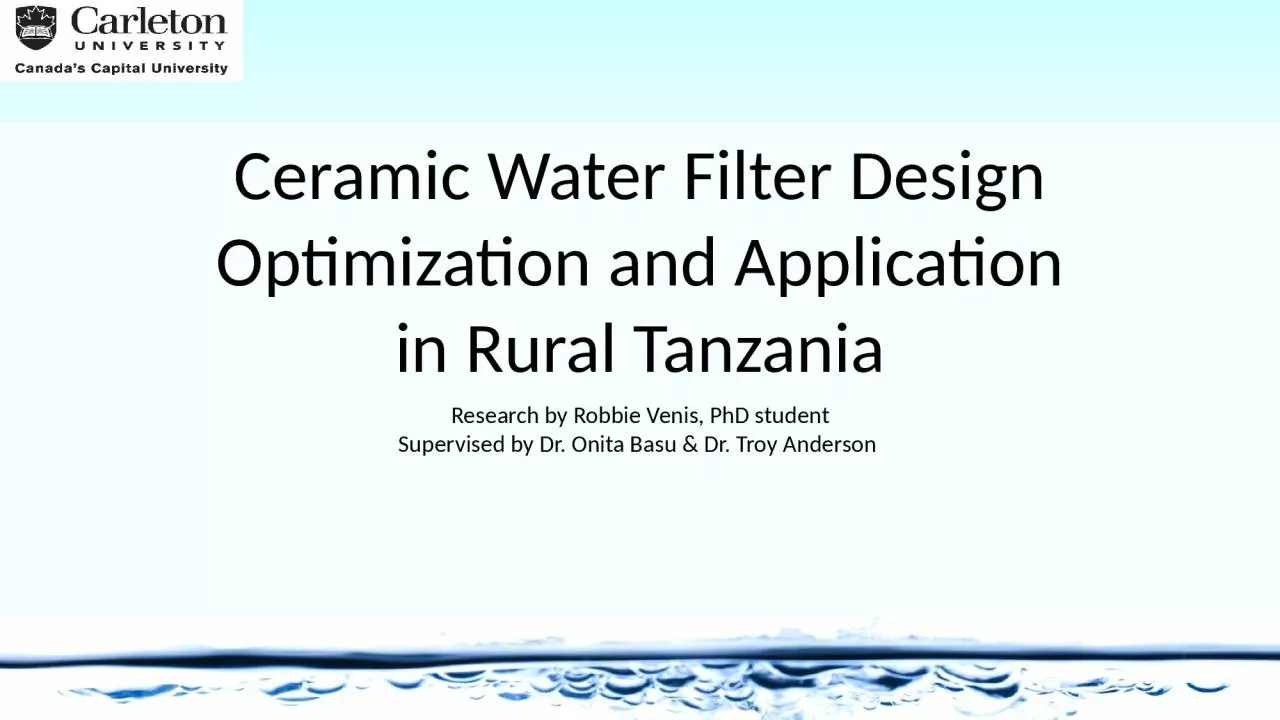

Research by Robbie Venis PhD student Supervised by Dr Onita Basu amp Dr Troy Anderson The Need for a Clean Water Solution In 2015 670m people without clean water 540m are rural 12 ID: 1048123
Download Presentation The PPT/PDF document "Ceramic Water Filter Design Optimization..." is the property of its rightful owner. Permission is granted to download and print the materials on this web site for personal, non-commercial use only, and to display it on your personal computer provided you do not modify the materials and that you retain all copyright notices contained in the materials. By downloading content from our website, you accept the terms of this agreement.
1. Ceramic Water Filter Design Optimization and Application in Rural TanzaniaResearch by Robbie Venis, PhD studentSupervised by Dr. Onita Basu & Dr. Troy Anderson
2. The Need for a Clean Water SolutionIn 2015, ~670m people without clean water; 540m are rural [1,2]Tanzania has ~59m people, ~26m without clean water ~22m rural vs. ~4 m urban [1,2]Centralized water infrastructure is expensive Climate Change will only make things worse [4]An Interim Solution: Point of Use Water Treatment SystemsFIGURE 1: CLIPART WATER DROP [5]1
3. Ceramic Water FiltersFIGURE 2: SAFE WATER CERAMICS OF EAST AFRICA’S MAJI SALAMAA FILTERSMixture of clay, firing material (FM), water, silverAfter firing in kiln, FM burns away leaving pore networkPores physically strip contaminants from water Silver acts as secondary disinfectantTEMBO are implementation Partner NGOSafe Water Ceramics of East Africa are current producers and research partners2
4. 3 Major ChallengesUsers complain about slow flowrateFilter breakage is leading reason for disuse in field [6]Filter cost is too high Currently $45 USD = 90 000 TSH = 200 GHS = 32 550 MWKSilver accounts for ~40% of cost3
5. A Holistic Approach to Problem Solving3Community EngagementPractical ApplicationScientific InquiryCommunity needs set the technological requirementse.g. the need for a lower cost or higher flowrateObserved phenomena emerge from more granular activities. Practical results lead to theoretical questions of why we see what we doIllumination of scientific principles guiding filter performance creates opportunity for improving filters in the future
6. Research PlanFive Stages:Investigating the impacts of material parameters on turbidity and microbe removal absent of silverInvestigating the impacts of metal additive types and concentrations on microbe removal and release into effluentInvestigating material strength parameters and internal filter structures via destructive testingDesign optimization and data modellingField implementation and health monitoring7
7. Laboratory SetupFIGURE 3 - LABORATORY SETUP8
8. Phase 1: Parameter Correlations9Parameter of InterestRange of StudyClay:Sawdust Ratio (C:SD)50:50, 44:56, 40:60, 36:64Large:Small Particle Size Ratio (LP:SP)100:0, 60:40, 50:50, 60:40, 0:100Thickness (cm)1, 1.5, 2, 2.5Maximum Firing Temperature (~0C)650, 750, 850, 950Outcomes of Interest:Independent and combined (i.e. interactive) impacts on flowrateIndependent and combined impacts on LRVIndependent and combined impacts on MOR (Phase 3)Relationship with porosity and dry density of filters
9. Phase 2: Parameters of InterestMetal Additives:Silver Nanoparticles (Ag-NP)Colloidal Silver (Ag-C)Silver Nitrate (AgNO3)Zinc Oxide (ZnO)Cupric Oxide (CuO)MixturesWater Quality Parameters:Microbes (E. coli and/or Viruses)pHOxidation-Reduction Potential (ORP)Dissolved Oxygen (DO)Temperature (T)TurbidityFluoride Concentration (F-) 10
10. Phase 3: Destructive TestingModulus of RuptureTests: Saturated and UnsaturatedFIGURE 4: MODULUS OF RUPTURE TEST SCHEMATIC [7]Scanning Electron Microscopy (SEM)Energy Dispersion Spectroscopy (EDS)Lower ResolutionPorosity UniformityPore size distribution vs. sawdust sizeHigher ResolutionMetal-ceramic adhesionMetal distribution with filter thicknessElemental composition changes11
11. Phase 4: Field Implementation1) Education ProgrammingHigh-School WorkshopsPrimary-School EngagementWomen’s GroupsEducation CentresImpacts of Education on AdoptionFIGURE 5: STUDENTS AT LONGIDO PRIMARY SCHOOL (PHOTO BY DR. TROY ANDERSON)2) Health MonitoringDiarrhea Cases at Health CentresSeverity of DiarrheaMore Details TBDFIGURE 6: CLIPART HEALTH HEART [8]123) Marketing/Sales ManagementLocal shop salesSales via Health AuthoritiesSales via NGOImpacts of Marketing/Sales Model on Filter Adoption
12. Thank you for your time8